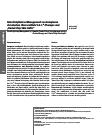Subscribe to RSS
DOI: 10.1055/s-2006-921460
© Georg Thieme Verlag Stuttgart · New York
Interdisziplinäres Management von komplexen chronischen Ulzera mittels V.A.C.®-Therapie und „Buried Chip Skin Grafts”
Interdisciplinary Management of Complex Chronic Ulcers Using Vacuum Assisted Closure Therapy and “Buried Chip Skin Grafts”Publication History
Publication Date:
30 March 2006 (online)

Zusammenfassung
Anamnese und Befund: Eine 68-jährige Patientin mit entgleistem Diabetes mellitus wurde in septischem Zustand in unsere Klinik aufgenommen. Als Ursache fanden sich komplexe chronische Ulzera an den unteren Extremitäten. Aufgrund der Progredienz der Ulzera hatte man der Patientin in einer auswärtigen Klinik zu einer beidseitigen Unterschenkel-Amputation geraten. Bei Aufnahme fand sich ein ausgeprägtes diabetisches Fußsyndrom mit multiplen, infizierten Ulzera im Stadium D IV nach Wagner und Armstrong, freiliegenden Sehnenanteilen und einer Phlegmone bis in den proximalen Unterschenkel. Untersuchungsergebnisse und klinischer Verlauf: Die vaskuläre Diagnostik ergab eine arterielle Verschlusskrankheit beider Unterschenkel ohne Rekonstruktionsmöglichkeit. In Abstrichen aus den Ulzera konnten Enterococcus faecalis und Staphylococcus aureus nachgewiesen werden. Unter antibiotischer Abschirmung und intensiver Korrektur der Stoffwechsel-Parameter erfolgte ein radikales Débridement aller Ulzera sowie die Einleitung einer Vakuum-Versiegelung aller Wunden. Nach vier Zyklen V.A.C.®-Therapie zeigten alle Wunden gute Granulationstendenz, so dass eine interdisziplinäre, plastisch-chirurgische Defektdeckung der Ulzera mittels „Buried Chip Skin Grafts” vorgenommen werden konnte. Die Fortsetzung der Vakuum-Versiegelung beschleunigte das Einheilen der Transplantate soweit, dass die Ulzera nach vier Wochen vollständig epithelialisiert waren. Die Patientin erholte sich gut und war bei Entlassung selbständig mobil. Diskussion und Schlussfolgerung: Ein zielgerichteter Einsatz der V.A.C.®-Therapie kann in einem interdisziplinären Therapie-Konzept auch bei septischen Krankheitsbildern den Extremitätenerhalt ermöglichen. „Buried Chip Skin Grafts” stellen in Verbindung mit der V.A.C.®-Therapie eine gute Alternative dar um eine schnelle und stabile Epithelialisation komplexer Ulzera zu erreichen.
Abstract
History and admission findings: We report the case of a 68-year-old female patient who was admitted to the hospital with deranged blood sugar levels in a septic condition. Due to complex chronic ulcerations of both feet she was intended for major amputation of both limbs. Clinical findings on admission were a diabetic foot syndrome with stage D IV ulcerations according to the Wagner and Armstrong classification, partially visible tendons and phlegmon of the lower leg. Investigations and clinical course: Vascular diagnostic revealed arterial occlusive disease in the lower legs without chance of reconstruction. Enterococcus faecalis and Staphylococcus aureus were extracted in swabs from ulcers. After correction of metabolic status and antibiotic treatment radical débridement of all ulcers was carried out and vacuum assisted closure therapy (V.A.C.®) was initiated. All wounds showed good granulation tissue after four cycles of V.A.C.®-therapy. Interdisciplinary treatment with a plastic surgeon was initiated to accelerate epithelial closure. Using the “Buried Skin Chip” technique in combination with V.A.C.®-therapy epithelialisation was completed within four weeks. The patient recovered well and was fully independent on discharge. Discussion and Conclusion: A goal-oriented interdisciplinary setting can achieve preservation of extremities even in septic patients. The combination of buried skin chip grafts and V.A.C.®-therapy may be a feasible and promising procedure to achieve accelerated wound closure in those patients.
Schlüsselwörter
V.A.C.®-Therapie - diabetisches Fußsyndrom - „Buried Chip Skin Grafts”
Key words
V.A.C.®-therapy - diabetic foot syndrome - buried chip skin grafts
Literatur
- 1 Kopp J, Kneser U, Bach A D, Horch R E. Buried chip skin grafting in neuropathic diabetic foot ulcers following vacuum-assisted wound bed preparation: enhancing a classic surgical tool with novel technologies. Int J Low Extrem Wounds. 2004; 3 168-171
- 2 Sawada Y. Buried chip skin grafting for treatment of perianal burns. Burns Incl Therm Inj. 1989; 15 36-38
- 3 Kopp J, Bach A D, Kneser U, Polykandriotis E, Loos B, Krickhahn M, Jeschke M G, Horch R E. Indication and clinical results of buried skin grafting to treat problematic wounds. Zentralbl Chir. 2004; 129 (Suppl 1) S129-S132
- 4 Goldberg J A, Alpert B S, Lineweaver W C, Buncke H J. Microvascular reconstruction of the lower extremity in the elderly. Clin Plast Surg. 1991; 18 459-465
- 5 Sawada Y, Nihei Y. A further application of buried chip skin grafting. Acta Chir Plast. 1998; 40 68-72
- 6 Armstrong D G, Lavery L A. Diabetic Foot Study Consortium . Negative pressure wound therapy after partial diabetic foot amputation: a multicentre, randomised controlled trial. Lancet. 2005; 366 1704-1710
Dr. M. Gesslein
Klinik für Unfall- und Orthopädische Chirurgie · Klinikum Nürnberg-Süd
Breslauer Str. 201
90471 Nürnberg
Phone: 09 11/3 98 26 00
Fax: 09 11/3 98 21 73
Email: mgesslein@aol.com

